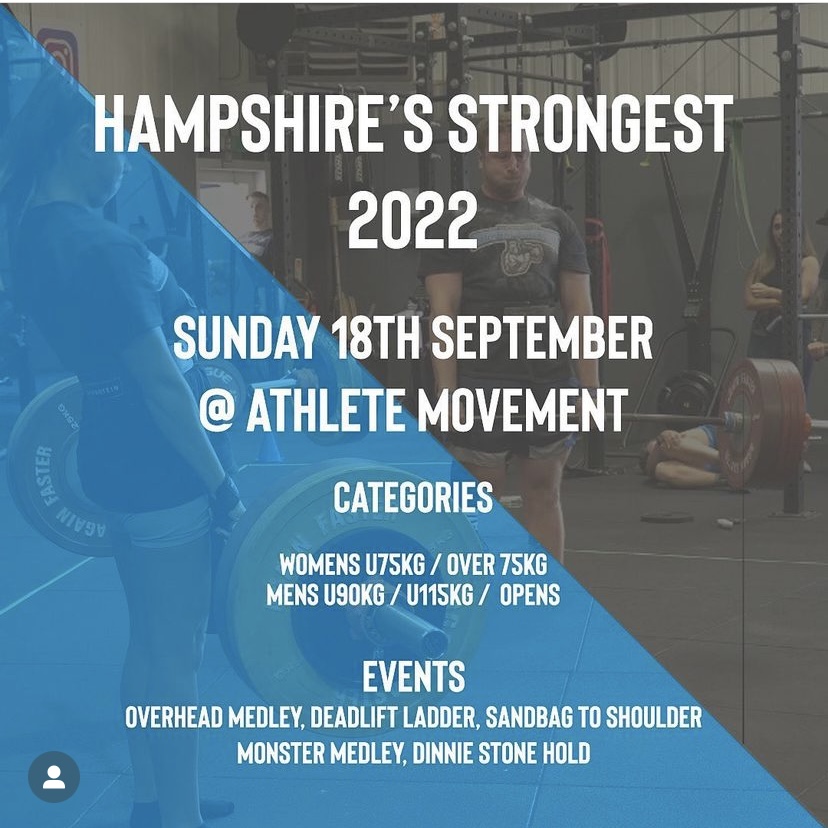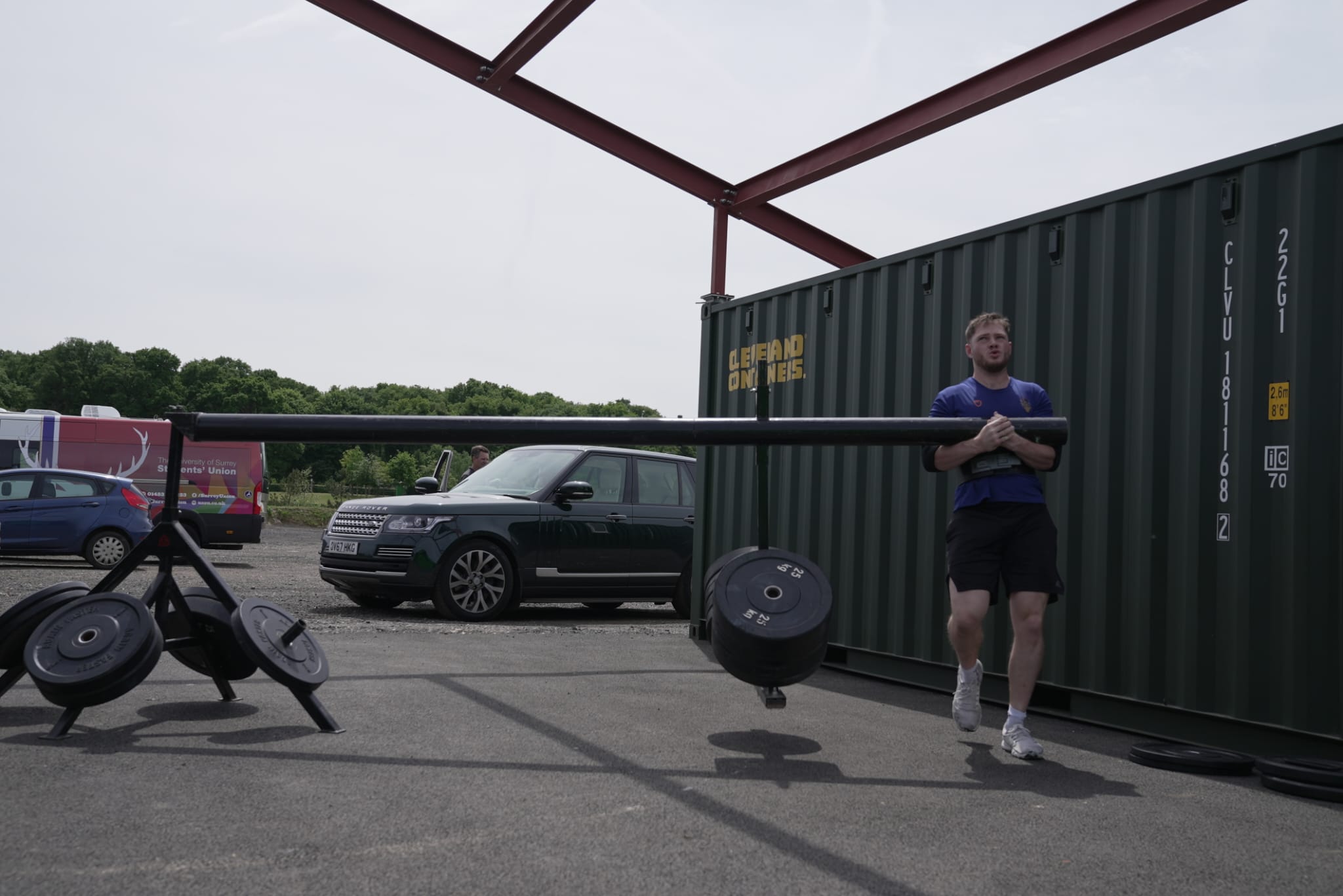You might not associate strongman or strongwoman with weight categories, but they do exist.
In fact, this article was inspired by Hampshire’s Strongest Man 2022, held at Athlete Movement and run by Ben Glasscock.

For those of you hovering around a weight category for a strongman competition, I’m going to show you how to approach cutting weight safely.
This article is not about sitting on a Concept bike, in a bin bag, half an hour before weighing in.
It’s about how to safely shift the last few kilos, without compromising your performance during your training or the competition itself.
If you want a quick fix, this article is not for you.
You might be more familiar with weight categories in fight sports, Olympic weightlifting, or powerlifting.
This article is still relevant to those sports, but the examples used are related to strongman.
To kick things off, what is cutting for a competition anyway?
The difference between losing fat and cutting water for a weight class competition
Losing fat:
You can think of fat as a body tissue that stores energy.
You lose fat by taking on less fuel (from food and drink) than you burn (from being alive and moving around) each day.
When you eat less energy than you burn you put yourself in a calorie deficit and your body taps into its tissue stores (fat and muscle) for energy.
Provided you eat enough protein whilst in a calorie deficit (the subject of another blog) then you will minimise the muscle you lose.
Losing or gaining tissue takes time, a few weeks or more, but you can lose more weight this way.
Cutting weight:
Cutting weight is altering what you weigh on the scales without making any significant change to your tissue stores.
It’s achieved by temporarily reducing the water and glycogen stored in your body.
Glycogen is the fancy name for stored carbohydrates in your muscles and liver. It’s there to supply instant access fuel because your body would rather use those stored carbohydrates for energy than stored fat or muscle.
Changes in water and glycogen can happen quickly, in a matter of days, but you can only lose a small amount of weight this way.
If you’ve ever gone out for a pizza and a few beers and woken up 2-4kg heavier the next day, part of this temporary increase is down to changes in stored water and glycogen.
Why cut weight for a strongman competition?
Weight classes exist to level the playing field when the sport is affected by body weight.
For example, an 80kg athlete will not often be able to pull a tractor as quickly as one that weighs 130kg because getting the thing moving is easier when you weigh more.
If two people of similar bodyweight pull the same tractor though, the playing field is level and the better athlete on the day will win.
Arguably, body fat percentage for strongman/strongwoman will depend on the events in that specific competition. Because ‘mass moves mass’.

What any athlete wants to avoid though is dragging around a bunch of extra fat that doesn’t contribute to their performance.
At a certain point, an athlete who competes in a weight category won’t be able to compete in a competitive class without losing more body fat than is optimal for performance.
Optimal depends on the individual and the sport but is usually 10-15% body fat for males, 15-20% for females.
If an athlete has achieved their optimal body fat level and are performing well in training, it would be a mistake for them to lose any more body fat.
Being shredded makes it incredibly difficult to perform at your true potential because a reasonable amount of body fat gives you a reserve of fuel for doing really challenging stuff.
For example, pro footballers tend to be lean, but they don’t look like a bodybuilder because performance, not how they look, tends to pay their bills!
Put another way, there aren’t many featherweight boxers wining fights against the equivalent heavyweight fighter.
As a side note, you may also have noticed, at the highest level, weight classes tend to be dictated by height (in drug free sports).
What is making weight for a competition
Let’s say you weigh 72kg and your body fat is in an optimum range.
You’re too heavy for a 70kg weight class but too light to be competitive in the 75kg weight class.
Adding 3kg of muscle (naturally) probably isn’t that realistic and would mean you’re carrying around extra body fat that may not be useful.
Losing 2kg of body fat would also be detrimental to your performance.
This is where cutting water is a smart strategy.
You get to ‘bend the rules’ by losing just over 2kg on the scales through manipulating the water and carbohydrate storage in your body just before the competition.
You can then regain that weight after weighing in and compete 2kg heavier than you weighed in.
Not a huge advantage in Strongman but there are other advantages.
The biggest one being that you won’t need to be in a calorie deficit, or in a sub-optimal body fat range ahead of competition.
Which makes what will no doubt be your hardest block of training, as you peak towards competition, way easier and more effective.
The risks of water cutting for competition
You might think ‘water cutting’ is all about dehydration.
You can make weight by manipulating carbohydrates alone. It’s very safe and done right there’s no reason for dehydration.
Dehydration kills your performance, but it can also be fatal, as shown in this tragic news story from Australia.
Yes, that’s an extreme case.
No, it’s not worth the risk… especially if you don’t know what you’re doing.
*Some weight class sports are even bringing in multiple weigh ins on the days leading up to competition where you can only be within a certain weight range to keep the whole process safer.
How to water cut safely (case study)
Before we start, if this is your first ever competition or fight, do not try and water cut. Get your training done and compete at whatever weight you are on the day.
If you’re not prepared to miss your weight, then don’t sign up to compete.
The advice below assumes you have some experience of competing and managing your calories and macronutrients around training.
With that experience under your belt, you’ll have a much better idea of what weight category you’ll be best suited to compete in.
For this case study, I’m going to use my friend Nick.
Nick is an experienced lifter, and he is reasonably lean (below 20%).
He’s competed in powerlifting, and he placed 3rd in the novice category of his first ever strongman competition (won by my other mate Nick Veira).

Nick weighs 95kg and originally wanted to push himself and compete in the under 110kg category at Hampshire’s Strongest Man 2022.
Bulking takes time and he was also unlucky enough to suffer a hamstring tear in his training so he decided to cut for the under 90kg category instead, where he would be way more competitive.
Even if he did choose to bulk, whilst he certainly has the ability to gain strength through improving technique and hard work, realistically he is not going to gain 15kg of lean muscle in 8 weeks without some high-grade pharmaceutical help…
As he gave himself a reasonable timeframe to get into his weight class (12 weeks), he could choose to lose fat conservatively.
A conservative rate of fat loss would be aiming to lose 0.5% of your bodyweight per week (on average).
Yes, you can lose fat faster than that but when performance is important, slower is better.
The strategy here would be to lose body fat until he is close to competition weight and then maintain that weight.
So, if Nick starts at 95kg he could expect to lose roughly 470g per week.
Meaning he could realistically lose 3-4kg in 8 weeks.
That would leave Nick around 91-92kg.
He’d then look to maintain that weight by increasing his calories slightly before water cutting the week before competition.
That’s because if you only have 2-5% of your bodyweight left to lose, arguably a better strategy is to shift that with a water cut because you don’t need to be in a calorie deficit during arguably the hardest phase of your training.
*Full disclosure, Nick is the first person I have advised on a water cut but this is the scientific way to do it safely. I’ll update the article with how he got on after he competes.
This isn’t the typical dehydration focussed cut because of the risks I talked about earlier.
Typically weigh ins can be 1-36h before competing.
The longer you have, the more time to replenish fluids and carbs so the closer towards 5% you can go.
Let’s assume a weigh in of 24h before comp.
A 24h weigh in means that you can safely lose anywhere up to 4% of your bodyweight beforehand, depending on personal tolerance.
The less time to refuel before weighing in, the less weight you can safely cut.
If you have less than 6hours between weigh in and competition, there is not sufficient time to refuel and rehydrate so the risks of a water cut (depleted fuel) are generally not worth the benefit of being in a lower weight category.
The exception would be a competition focussed on single reps (weightlifting or powerlifting) because you don’t need a full tank of glycogen to hit heavy singles.
How the water cut works:
This is a phase where you deplete water and glycogen from your body.
Step 1: Stop taking creatine
Many lifters take creatine to enhance their training performance. It allows you to squeeze out a couple more reps which over time lead to improved gains.
Creatine is stored in your muscles alongside water so if you stop taking it you might expect to lose another 1-2kg.
Step 2: Glycogen depletion
Remember, glycogen is stored carbohydrate.
Your body holds 3g of water for each gram of carbohydrate.
On average you might store 400-500g of glycogen in your body.
So, even at the lower end of that range you can expect to drop 1.6kg from reducing glycogen stores alone.
Glycogen stores are depleted by reducing your carbohydrate intake a few days before completion as your training also tapers off.
I’ll show a worked example later…
If you don’t already eat plenty of carbohydrates, then this won’t work as effectively but I’m going to assume that, as an advanced lifter, your diet is carb heavy.
The important thing to remember if you do deplete your glycogen is that you need to put it back.
Reviewing our example
Let’s assume that Nick has dieted his way to 92kg.
At that point he could simply stop taking his creatine 2 week’s out form competition and see what happens.
Sure, he may see a slight dip in gym performance, but it won’t be huge, and it is unlikely to make any difference on the day of the event.
If he still ends up a little bit over his weight category, he could choose to deplete his glycogen to shift the last bit of weight.
He would do this by gradually reducing his carbohydrate intake the week before competition as his training tapers off:
| Day | Training | Carbs |
|---|---|---|
| Saturday | Programmed | 450g |
| Sunday | Programmed | 350g |
| Monday | Programmed | 350g |
| Tuesday | Programmed | 350g |
| Wednesday | Programmed | 350g |
| Thursday | Stop | 250g |
| Friday | Walk | 150g |
| Saturday | Rest | 100g |
| Sunday | Competition Day | Replenish (after weigh in) |
Note: this is not a training article. Get yourself a proper program with a proper taper. Reach out to Ben Glasscock or James Matthews If you need a strongman program!
Other Strategies:
Manipulating water so that you pee more in the week before comp is a choice that many people use.
As you’ll have read above, dehydration not only kills performance, but it can also be fatal.
It is a last resort strategy, reserved for professionals.
Please don’t do anything extreme with your water or salt intake!
No competition is worth risking your health for.
If you miss weight, learn the lessons for next time rather than doing something stupid to make weight.
After the weigh in:
After the weigh in, the point is not to regain the lost weight (although it will happen).
The point is to regain any lost glycogen and (possibly) water.
If you are doing powerlifting or Olympic weightlifting, your primary energy comes from the phosphocreatine system (used to fuel single reps). Therefore, restoring lost glycogen is less important.
Of course, training has more volume and so you need carbs in the build-up to a competition, but that’s why carbs taper down when you stop training.
If you are doing a fight sport, then carb replenishment is important. You probably want to be well fuelled, and on your game, if there’s a risk of being punched in the face!
Arguably strongman is somewhere in the middle of the two extremes.
Here’s an optimal strategy for refuelling carbs which is more aligned to fighting but won’t harm a strongman competitor either:
- Re-fill your glycogen stores by increasing carbohydrates 1.5 times the amount you were eating before the water cut (this might have to be liquids if there isn’t a big gap between weigh in and comp)
- Focus on easily digestible carbs so that you are not too full and don’t have any stomach problems
- Hydration is always a good strategy before any event or competition
- An electrolyte drink or something isotonic like Lucozade is a good bet
- Don’t eat really filling foods (oats, beans, fatty cuts of meat and stuff high in protein). Focus on eating carbs as they will make the biggest difference in the short term.
- Take your time refuelling. If you feel full, slow down and let your digestive system work. Chip away at the targets and split meals evenly across the time you have available
What strongmen and strongwomen should take away from the above is that ‘carbing back up’ after weighing in may be helpful for a longer event day involving lots of work. But if you’re only likely to hit a bunch of singles then you don’t have to sweat the detail.
Fuelling yourself during comp:
You might be wondering what you should eat on the morning of a competition and throughout the day.
Firstly, relax, you’ve done enough by this point!
Start the day with a small, easy to digest breakfast aimed at toping up your glycogen stores and blood sugar beforehand.
Eat at your usual mealtimes and pick foods that sit well on your stomach that you have tried before.
As the day goes on, grazing on something like a banana, energy bar, a few dried apricots or some jelly babies will help to top up the glucose in your bloodstream between your regular meals, if you’re feeling a bit low.
Just make sure if you go down the sugar route that you don’t have too much because it may upset your stomach.

In Summary
The most important thing for you to remember from this article is that if you are close to your weight category then a water cut might be worth exploring.
Water cutting by manipulating your carbohydrates requires planning but is by far the safest way to make weight close to competition.
Remember if this is your first competition or event, do not water cut.
Did I explain that in a way you could easily digest (pun intended)?
If you’ve got a question, post it in the comments, I reply to them all!
Know someone this would help? Give it a share on your favourite social media platform using the links below 👊
References:
BTN Academy: Sports Nutrition in Practice – Bainbridge, Coomber, Herbert, Crossland, Patterson



